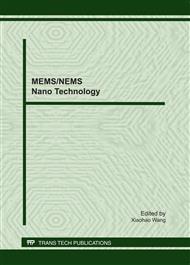p.750
p.755
p.760
p.765
p.770
p.775
p.779
p.784
p.789
Piezoresistive Sensitivity and Al Ohmic Contact of Highly Doped Polycrystalline Silicon Nano Thin Films
Abstract:
The piezoresistive and ohmic contact properties of polycrystalline silicon nano thin films were investigated in this paper. The polycrystalline silicon films with different thicknesses and doping concentrations were deposited by LPCVD and doped with boron highly, and then the cantilever beam samples were fabricated by photolithography and wet etching. By measuring the gauge factor and specific contact resistivity, the specific contact resistivity of Al contacts can reach 2.4×10-3Ω·cm2 after the alloying at 450 °C for 20 min; the enhanced piezoresistive effect of highly doped polycrystalline silicon nano thin films was discovered. The conclusions indicated that the enhanced piezoresistive sensitivity of PNTFs is due to the modification of depletion region barrier by ultra high doping and film thickness thinning and the enhancement of tunneling piezoresistive effect. The distinct piezoresistive phenomenon of PNTFs could be utilized for the development and fabrication of miniature piezoresistive sensors.
Info:
Periodical:
Pages:
789-793
Citation:
Online since:
June 2011
Authors:
Price:
Сopyright:
© 2011 Trans Tech Publications Ltd. All Rights Reserved
Share:
Citation:


